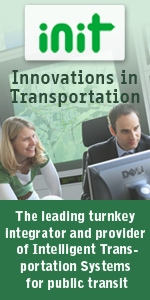

| In This Issue |
| » BREAKING NEWS |
| » NEWS HEADLINES |
| » SAFETY AND SECURITY |
| » COMMENTARY |
| » PEOPLE ON THE MOVE |

The 14 help wanted ads in this week's classifieds offer such jobs as a transit agency general manager and an executive director in academia!
| SAFETY AND SECURITY |
Are We Mitigating Risk for Public Transportation?
BY JOHN WALSH, Chief Research and Strategy Officer, Clever Devices Inc.
Safety and security issues always have been important to public transportation operators, but a more focused and strategic approach is taking a far greater role than in the past concerning how we operate these networks. Many transit professionals did not understand that their systems were a target for terrorism, despite the attacks on public transit worldwide well before the terrorist attacks of Sept. 11, 2001.
The post-9/11 world has changed our level of concern, and the transit industry has developed and implemented many proactive security measures and strategies, but the question remains: has public transportation received enough attention and resources to mitigate risk and reduce its vulnerability as a “soft target” for terrorism?
The threat of a terrorist attack is not a question of “if,” but of “when.” When 9/11 happened, we as a nation emerged, stunned, from the cocooned comfort of our thinking to the stark reality of a very real terrorist attack. That day’s events forever changed the definition of security and safety for all.
We have hardened our facilities; developed and implemented well-conceived audit and incident procedures, practices for security measures, increased policing, and security presence throughout the public transportation infrastructure; trained our employees; and raised the awareness of our customers and the general population. All of these measures have reduced the vulnerability of transit systems to acts of terrorism. But is it enough? What else can transit agencies do without defeating their purpose—to transport people safely and efficiently?
Over the past nine years, much of the industry and adjunct regulators, suppliers, researchers, other experts, and advisors have wrestled with the delicate balance of system security vs. reasonable access and usability of transit. The problem is how to increase security on public buses and light and heavy rail systems while keeping them usable and practical as transport options.
Let’s also remember that cyber threats can be just as damaging as physical ones. With multitasking technologies deployed on rail and bus systems, including the ability to discover unusual objects, technology can be very effective in identifying and subsequently deterring possible threats. Couple this technology with a strong campaign, such as New York’s “If you see something, say something,” and we drastically decrease threats. We need to create and continue collaborative campaigns such as these; they cannot and should not be isolated campaigns that serve as standalones.
We can implement some measures at reasonable cost and transparency to our customers: for example, leveraging currently deployed technologies and integrating emerging commercial security technologies that further reduce our vulnerability to attack.
Many public transit agencies have deployed an array of communication technologies, such as computer-aided dispatch/automatic vehicle location technology and stationary and mobile closed-circuit television. Beyond that, many standard vehicle systems can multitask to additional safety and security functionalities. Biological, explosive, chemical, and the like sensor technologies are mature, and with some modification for mobile environments, could we not integrate them as they become available, reliable, and affordable?
Object recognition, pattern detection, geofencing, and system controls software exist and can integrate with existing and deploying transport technology solutions.
While funding remains an issue, we still have to plan to effectively mitigate risk. A full risk assessment will pinpoint risks so we may then allocate the available dollars to secure those risks.
We are only at the beginning of using technology applications that will assist in improving the level of safety and security in our public transportation systems. We need to increase our usage of technology as a solution so we are prepared to prevent future events, diminish consequences, and have an immediate and available solution for rapid deployment in the event of an emergency. Think of natural disasters like Hurricane Katrina.
In addition, our transit infrastructure is aging and the demand for service continues to rise. Americans took a record 10.3 billion trips on public transportation in 2008, surpassing increases in any other mode of transportation—yet budgets and people have been cut. At the very least, don’t we need to adopt a “better safe than sorry” attitude when it comes to justifying investment?
Preventive maintenance is an eligible capital project expense for transit agencies in both large and small urbanized areas. Nearly half of the nation’s urban bus maintenance facilities are more than 21 years old, and nearly one-third of urban bus maintenance facilities are in marginal or poor condition.
Currently available technology has capabilities that will amaze you. Data that in the past were too massive to be collected now can be, as can data once thought too dense to calibrate into reports.
Making transportation smarter also makes it safer, so we need to take these measures to truly ensure safety. Together we can establish a true road map to excellence for public transit, because upping our game in safety and security is an investment in all our futures.
While some of this may be a stretch, these technology measures and security capabilities are closer than we think. Aren’t they worth consideration and evaluation in our strategies for technology deployment and implementation?
The answering is an emphatic “yes.” At the very least, we should be considering and thinking about every alternative. Aren’t people worth it?
| « Previous Article | Return to Top | Return to Main | Next Article » |
|
||||||
| AMERICAN PUBLIC TRANSPORTATION ASSOCIATION |
Telephone (202) 496-4800 • Fax (202) 496-4321
Search Back Issues
